 W
WPietà or Pietà with Mary Magdalene is a 1529 painting by Bronzino, produced early in his career and now in the Uffizi in Florence.
 W
WPietà is a c.1600 oil on canvas painting by Annibale Carracci, the earliest surviving work by him on the subject, commissioned by Odoardo Farnese. It moved from Rome to Parma to Naples as part of the Farnese collection and is now in the National Museum of Capodimonte in Naples.
 W
WPietà with Saint Francis and Saint Mary Magdalene is a 1602-1607 oil on canvas painting by Annibale Carraci. Now in the Louvre, it was looted from the Mattei family chapel in San Francesco a Ripa in Rome by Napoleon's troops in 1797 and was not returned at the end of the Napoleonic Wars.
 W
WPietà with Saints Clare, Francis and Mary Magdalene is a 1585 oil on canvas painting by Annibale Carracci, now in the Galleria nazionale di Parma.
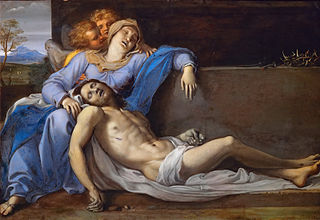 W
WPietà with Two Angels is a oil on copper painting by Annibale Carracci, created c. 1603, now in the Kunsthistorisches Museum in Vienna.
 W
WThe Dead Christ Mourned is an oil painting on canvas of c. 1604 by Annibale Carracci. It was in the Orleans Collection before arriving in Great Britain in 1798. In 1913 it was donated to the National Gallery, London, which describes it as "perhaps the most poignant image in [its] collection of the pietà – the lamentation over the dead Christ following his crucifixion – and one of the greatest expressions of grief in Baroque art".
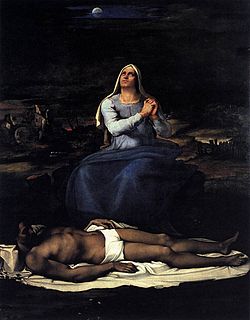 W
WPietà is a oil on panel painting by Sebastiano del Piombo, executed c. 1516-1517, now in the Museo civico in Viterbo.
 W
WPietà is a 1571-1576 painting by El Greco, produced just after his arrival in Rome and with clear influence from Michelangelo, although the triangular composition is El Greco's own invention. In the background is a landscape scene. It is now in the Philadelphia Museum of Art.
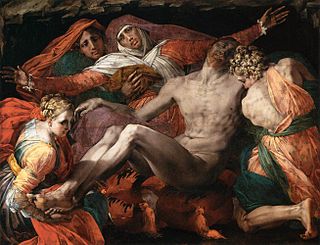 W
WPietà is a c.1537-1540 oil painting by Rosso Fiorentino, originally painted on panel and later transferred to canvas. Now in the Louvre in Paris, it is the only securely-identified original painting by the artist known to have been produced for a courtier of Francis I of France. X-ray examination has shown an initial composition under the bodies of Christ and St John.
 W
WPietà is an oil on canvas painting by Lorenzo Lotto, signed "Laurentio Lotto". It is mentioned in Lotto's account books as being commissioned in 1538 for the altar dedicated to the Pietà in the Dominican Church of San Paolo in Treviso. The account books also mention that the work was completed in 1545. That church was suppressed under the Napoleonic regime late in the 18th century and in 1811 the painting was bought for 12 ducats by the Pinacoteca di Brera in Milan, where it still hangs.
 W
WThe Massa Fermana Altarpiece is a 1468 tempera and gold on panel by Carlo Crivelli, held in Santi Lorenzo e Silvestro church in the town of Massa Fermana. It is signed "KAROLVS CRIVELLVS VENETVS PINXIT HOC OPVS MCCCCLXVIII". It is his earliest known surviving work and is notable for dating his return to Italy.
 W
WPietà is a painting by the Italian Renaissance artist Pietro Perugino, executed around 1483-1493, and housed in the Uffizi Gallery, Florence.
 W
WCopies by Vincent van Gogh form an important group of paintings executed by Vincent van Gogh between 1887 and early 1890. While at Saint-Paul asylum in Saint-Rémy-de-Provence, France, where Van Gogh admitted himself, he strived to have subjects during the cold winter months. Seeking to be reinvigorated artistically, Van Gogh did more than 30 copies of works by some of his favorite artists. About twenty-one of the works were copies after, or inspired by, Jean-François Millet. Rather than replicate, Van Gogh sought to translate the subjects and composition through his perspective, color, and technique. Spiritual meaning and emotional comfort were expressed through symbolism and color. His brother Theo van Gogh would call the pieces in the series some of his best work.
 W
WPietà or Lamentation over the Dead Christ is a fragment of a lunette fresco of c. 1475–1500 by Bramantino, originally over the door of the church of San Sepolcro in Milan and now in the Pinacoteca Ambrosiana in the same city.
 W
WThe Pietà is a 1437-1439 tempera on panel painting by Filippo Lippi, now in the Museo Poldi Pezzoli in Milan.
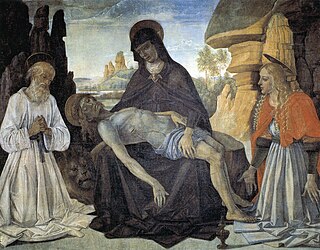 W
WThe Pietà Gonfalon is a c. 1472 tempera on canvas painting by Pietro Perugino, now in the Galleria Nazionale dell'Umbria in Perugia. It was produced as a gonfalon or processional banner for the Franciscan monastery at Farneto, near Perugia. It is an early work by the artist and shows the Pietà.
 W
WPortable Altarpiece with Pietà and Saints is a 1603 oil on canvas painting by Annibale Carracci in a gold, ebony and copper frame. It is now in the Galleria Nazionale d'Arte Antica in Rome.
 W
WThe Porto San Giorgio Altarpiece or Porto San Giorgio Polytpych was a 1470 multi-panel tempera and gold on panel altarpiece by Carlo Crivelli. Stylistically similar to Crivelli's Massa Fermana Altarpiece, the work was a fundamental step in his evolution away from the Paduan Renaissance towards a more delicate and realist style.
 W
WThe Pietà is a painting by José de Ribera, "The Españoleto", painted, signed and dated in 1633.
 W
WPietà is painting of 1637 by the Spanish artist Jusepe de Ribera, produced for the Tesoro Nuovo chapel in the Certosa di San Martino in Naples, where it still hangs.
 W
WThe Roverella Altarpiece was a 1470–1474 oil and egg-tempera on poplar panel work by Cosmè Tura, commissioned by abbot and cardinal Bartolomeo Roverella for San Giorgio fuori le mura in Ferrara in memory of his brother bishop Lorenzo Roverella. It was damaged in an explosion in 1709 and moved out of the church. It is now split up between several museums.
 W
WThe Spello Pietà is a fresco of the Pietà by Perugino executed in 1521-1522. It also shows John the Apostle and Mary Magdalene kneeling either side of the Virgin Mary. It is now sited in the left transept of the Chiesa Santa Maria Maggiore in Spello, but its origins are unknown.
 W
WThe Pietà now in the Gallerie dell'Accademia in Venice is one of the last paintings by the Italian master Titian, and in its final, extended state was left incomplete at his death in 1576, to be completed by Palma Giovane. Titian had intended it to hang over his grave, and the two stages of painting were to make it fit in two different churches.
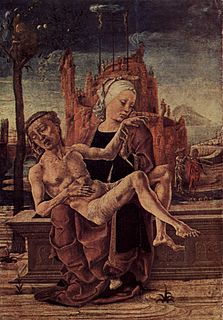 W
WPietà is a tempera on panel painting by Cosmè Tura, measuring 47.7 cm by 33.5 cm. It is now in the Museo Correr in Venice, to which it was left with the rest of the collection of Teodoro Correr on 1 January 1830. It was attributed to Luca d'Olanda until 1859, when Vincenzo Lazari recognised it as a work by Tura. By comparison with the same artist's Calliope and his Roverella Altarpiece, it has been dated to the 1460s.
 W
WPietà is a painting by the Flemish artist Rogier van der Weyden dating from about 1441 held in the Royal Museums of Fine Arts of Belgium, Brussels. There are number of workshop versions and copies, notably in the National Gallery, London, in the Prado, Madrid, and in the Manzoni Collection, Naples. Infra-red and X-radiograph evidence suggest that the Brussels version was painted by van der Weyden himself, not necessarily excluding the help of workshop assistants. Dendrochronological analysis gives a felling date of 1431 for the oak panel backing, supporting the dating of the painting to around 1441.
 W
WPietà of Villeneuve-lès-Avignon is an oil painting of the mid-15th century that is considered one of the outstanding works of art of the late Middle Ages. Following its appearance at an exhibition in 1904 its authorship was disputed, though it has since been accepted as the work of Enguerrand Quarton. It is now in the Musée du Louvre.